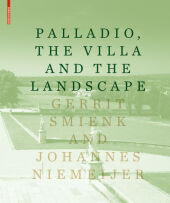 Neuerscheinungen 2011Stand: 2020-01-07 |
Schnellsuche
ISBN/Stichwort/Autor
|
Herderstraße 10
10625 Berlin
Tel.: 030 315 714 16
Fax 030 315 714 14
info@buchspektrum.de |

Johannes Niemeijer, Gerrit Smienk
(Beteiligte)
Palladio, the Villa and the Landscape
2011. 160 S. 160 p., 287 colour ills., 101 bw ills. 297 mm
Verlag/Jahr: BIRKHÄUSER BERLIN 2011
ISBN: 3-03-460712-1 (3034607121)
Neue ISBN: 978-3-03-460712-4 (9783034607124)
Preis und Lieferzeit: Bitte klicken
Andrea Palladio is universally regarded as one of the most important architects of the Re-naissance. He was the first "professional architect" and was strongly influenced by Greek and Roman architecture, particularly by Vitruvius. His treatise "Quattro libri dell´architettura" also earned him worldwide recognition. Palladio´s villas meanwhile are UNESCO World Heritage Sites. This book documents and analyzes ten of Palladio´s eighteen surviving villas specifically in terms of their relationship with their natural surroundings; their influence on those surroundings is investigated as well. The selected villas constitute a representative cross section of Palladio´s wide-ranging output. The landscape formations of Veneto, where these villas are located, may be divided into three types: plains surrounded by mountains, arid plains, and marshland. Gerrit Smienk is a landscape architect with many years teaching experience at the TU Delft and the Berlage Institute, Rotterdam, and is a recognized expert on the Italian Renaissance. Andrea Palladio kann zweifelsohne als einer der bedeutendsten Architekten weltweit gelten. Er war der erste "Berufsarchitekt" und wurde durch die römische und griechische Architektur, vornehmlich Vitruv, stark geprägt. Auch seine Abhandlung "Quattro libri dell´architettura" brachte ihm weltweit Anerkennung. Die Villen Palladios gehören inzwischen dem UNESCO Weltkulturerbe an. Die ausgestellten Villen bilden einen repräsentativen Querschnitt des umfangreichen Schaffens Palladios. Die Landschaftsformationen Venetiens, in denen diese Villen stehen, lassen sich in drei Typen aufgliedern: Ebenen, von Bergen umsäumt, Trockenebenen und Marschland. Im Buch werden zehn der 18 erhaltenen Villen Palladios in ihrem spezifischen Zusammenhang zu ihrer jeweiligen landschaftlichen Umgebung dokumentieren und analysieren, ihr Einfluss auf das Landschaftsbild wird untersucht. Der Autor Gerrit Smienk lehrte als Landschaftsarchitekt über viele Jahre an der TU Delft und dem Berlage Institute in Rotterdam und ist ein ausgewiesener Kenner der italienischen Renaissance
Contents
OVERVIEW
Palladio, theory and practice
Exploring the villas from the air
Traces
Indicators and predecessors
Interpretations and research questions
THE RE-CREATION OF THE VENETIAN TERRAFERMA
State intervention
Drainage and reclamation
Low land and high water
High land and low water
The re-creation of the Venetian terraferma
TEN SELECETED VILLAS
Villa Godi: Recomposing the landsacape
Villa Saraceno: Breathing in the landscape
Villa Pisani in Bagnolo: The jump across the river
Villa Poiana: Broad composition
Villa Badoer: Separation and embrace
Villa Foscari: "In splendid isolation"
Villa Cornaro: Long sightlines
Villa Barbaro: Water machine at the foot of the mountains
Villa Emo: A focal point in an agricultural landscape
Villa Rotonda: All-round symmetry and different on all sides
THE AGRICULTURAL VILLA AS MODEL FARM
The laws of architecture
A paradoxical problem
The residence
The coperto, or farm buildings
The farmyard
Variations on the model
The essence of the model
Plan development in three directions
Spatial synthesis
THE VILLA IN A PRODUCTION LANDSCAPE
Framing
The agricultural domain and parcellation
Buildings and artefacts
Beacons in the landscape
The secret of Palladian staging
BIBLIOGRAPHY
INDEX
ILLUSTRATION CREDITS


